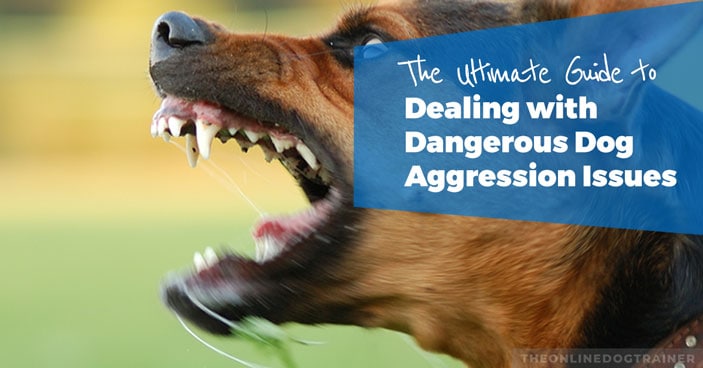
Dog aggression. It’s one of the biggest reasons that people…
- Dump their dogs on the side of the road.
- Send their dogs to shelters.
- Have their dogs euthanized.
It’s heartbreaking and tragic, but it happens every day.
Why? Because people truly don’t believe that there is hope to change the behaviour of a dog. And they fear that a dog’s aggressive tendencies may put themselves or the people they love in danger.
Before we go any further, I want to say that I get it. And I don’t blame anyone who takes preventative measures to ensure they stay safe.
I myself have a family. And I would do anything in my power to ensure my beautiful wife and children were kept safe from any harm that could come their way.
That being said, I also know that dog aggression is an issue that can be fixed. And with a little time and training, any aggressive dog can be given a second chance at living a safe, happy and healthy life.
In fact, if you're looking for a quality program to help get you started, I highly recommend you check out The Dog Calming Code.
Or, if you have a puppy, I recommend starting with my Puppy Coach training program.
These training programs will give you all the training tools you need to help get your dog to calm down and relax so that aggression isn't an issue.
In just a minute, I’m going to share a collection of articles I wrote that address the topic of dog aggression (both dog-on-dog aggression and human aggression). Read everything from start to finish, and I guarantee that you’ll be a lot closer to understanding how to help your dog (or a family member/friend’s dog) that has aggressive tendencies.
But there’s one more thing I want to make clear…
There are many ways you can help a dog get over aggressive issues. In some cases, you’ll be able to use the tips I give you and find success. In other cases, it might be necessary to rehome a dog–especially if you have small children or other animals that are at risk.
Example: You may have a dog who is loving toward people, but hates cats. If you can’t curb this behaviour, the cat’s life is at risk. This might mean you need to find a new loving home for the dog with someone who does not own cats.
Certainly, the goal is to find a solution so the dog and cat can live peacefully side by side–and it can be done! But, if after using my training techniques and consulting with a dog trainer, the behavior isn’t changing, you may have to reevaluate your situation.
It’s your responsibility to do both what’s best for your dog and what’s best for your family. And if you’re currently in a situation where lives (of both humans or animals) are at risk, you need to take that into consideration.
With a little work, it is possible to find a happy ending for both you and your dog. So, without further ado, let’s jump into it!
Fear Aggression Training: The Amazing Ability for Dogs to Change
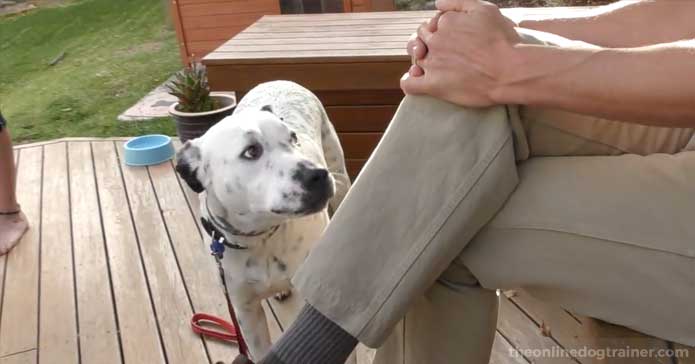
I remember my mum telling me when I was young…
‘You know what I love about you, Dan? You always look after the kids that are weak and need help.’ She wasn’t talking about dogs at the time, but it’s true.
And I guess I haven’t changed!
My heart always wants to reach out and help. This morning I was able to help a sea bird injured on the beach, and I often rescue honey bees I find lying exhausted around the property. All they need is a little sugar solution and a place to rest before heading off in the morning back to their hive.
I’ve always loved the underdog.
Buck, a dog I’ve had the privilege of working with, is one of those ‘underdogs’ who totally captured my heart. He’s a dog I learned a lot from…and I think you will too.
So, before you continue, check out this quick video clip of me working with Buck.
Now that you’ve watched the video, I thought I’d share with you a few things that come to mind as I look back at my time with Buck about dog aggression, fear and the ability that dogs have to change.Read the rest of Buck’s story here.
Training Aggressive Dogs: Understanding Dominant and Fearful Aggression
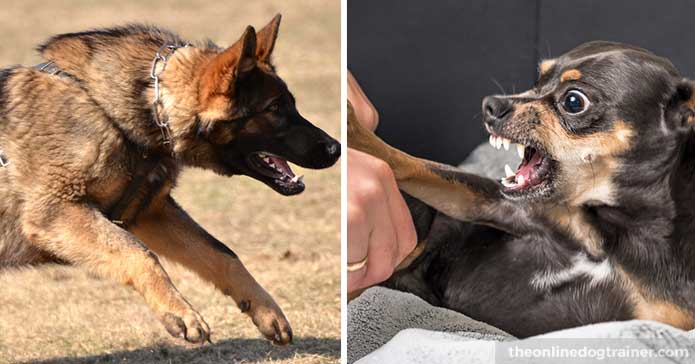
Over the years, I’ve worked with thousands of unruly and aggressive dogs who were hostile to other dogs. And that’s what this is about…understanding dog-on-dog aggression.
One encounter that sticks in my memory is a Great Dane Border Collie cross who weighed close to 80 kg and was so aggressive that when I brought him out of the car on a double leash my dogs hid in the bushes on the far side of the park.
On the other end of the spectrum, I’ve also seen tiny little dogs snap away at my biggest dog, Jack, whilst he calmly ignored them and carried on smelling the flowers!
And from these experiences, I’ve learned that size, breed, color, etc., tend to have nothing to do with why a dog is aggressive.
With that in mind, I know that when working with an aggressive dog, I have to answer a few questions…
‘Why did they do what they did?’
‘What was the goal of their aggression?’
‘What made them do it?’
If we can answer those questions, then we get a better understanding of where a dog is coming from and then can form an approach that will help him start to relax and overcome his aggression.
Clearly, there are many different reasons why a dog may be aggressive. He may have a fear of something happening. His aggression may be linked to some previous abuse. Or he may feel threatened of somebody or simply have a serious lack of confidence.
If I tried to go into all of those problems, we’d be here for days.
So, today my focus is going to be on how to better understand the difference between dominant and fearful aggression–two of the most common types of aggression. Then you’ll be able to get an idea of what you can do to help aggressive dogs.
Keep reading to discover more about the different types of aggression.
Stop Dog-on-Dog Aggression At Home
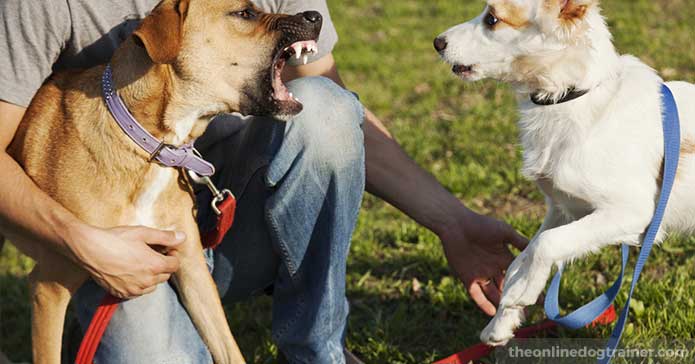
Dog aggression between dogs living in the same home is an interesting topic for a number of reasons. The main one has to be the question ‘Why would two dogs who have lived together, often for many years, suddenly attack each other?’
Let’s explore: Why are my dogs fighting?
Now, I should mention here that I am not talking about little squabbles, growls and minor disagreements. This sort of behavior is commonplace and usually over in a matter of seconds with absolutely no damage or injuries to speak of.
Over the years you become used to hearing loud eruptions of noise in another room, and sprint to the scene of the crime only to find all the dogs lying around quite happily looking at you as if to say, ‘What’s the problem? No drama, we’ve sorted it out.’
Serious fighting
The serious fighting that I am talking about is very different–where the dogs are out to injure, dominate or hurt the other dog. It leads to puncture wounds, visits to the vet and can end up very serious.
In this situation, it is clear that the dogs are not scared of each other, like they may be of an unknown dog that happens to pass by the property. And, after a fight, the dogs may be wary and display some signs of fear for one another, which generally subsides until the next flare-up. But, this behavior still doesn’t explain why, after years of playing together, they have suddenly become arch-enemies.
Triggers are not the key
Even though there may be an obvious trigger that has set the dogs off, do not be fooled into thinking this is the cause of the problem. A bone, a ball, trying to receive pats or cuddles from an owner or increased stress levels in a home can all add to the chance of dogs fighting–but it’s not the cause. The real long-term solution does not lie in the trigger.
Power of the pack
To understand a dog, you need to recognize the power of the pack and the need to have strong pack leaders who are lovingly showing them the way to behave. When they are not present, the dogs will do their best to fill the vacant position.
With two dogs present and no human filling the role of decision maker or leader, it is often a case that they will simply fight it out between them to see who will be in charge.
Of course, every situation is different in the details, but in a nutshell, this is how the dogs see it, and the solution is no different. You need to become the pack leader. The solution is that simple.
In-home fighting is not something that can be solved using pats, cuddles, positive reinforcement and treats alone. You need something more. I often say it's about understanding dog psychology and where the dog is coming from rather than just ‘training the dog’.
Continue reading to learn more about becoming the pack leader here.
When Dogs Bite Their Owners – Why It Happens and How to Prevent It
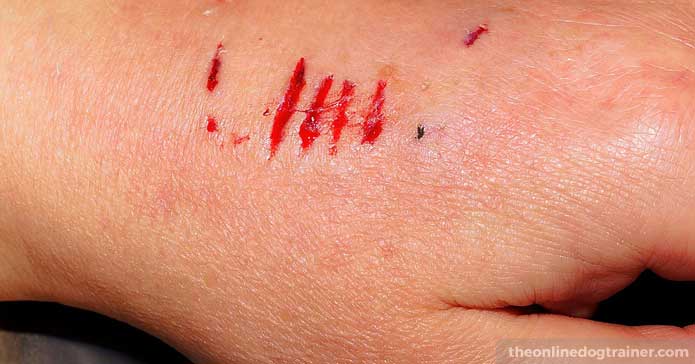
Ever wondered why on earth a dog would bite his owner? Or maybe your question is even closer to home, such as, ‘why did my dog bite ME?’
Why did they do it? Was it random? Have they tasted blood? Is this the end? Can anyone help now? Is it too late?
When dogs bite it can be extremely stressful for all involved. The good news is that there is a solution, and it’s not rocket science.
To get a better understanding of why dogs bite and how to prevent it, listen to this audio I created just for you.
After you’ve listened to the audio, read the rest of the post here.
Excited and Aggressive Dog Greetings

Excitement or Aggression?
‘So, is my dog being aggressive, or is he just excited?’ This is the big question that many people are asking themselves (and often me) as their dogs race up bounding and barking at dogs that they meet.
The answer is not simply one or the other, and in most cases, I would suggest it is a bit of both. As I explain in the podcast, the more excited your dog is, the more chance that his behaviour may be interpreted as aggressive or threatening. The calmer your dog is, the better your chances of a calm encounter.
What should you do when your dog is pulling and lunging?
Listen to my podcast to find out…
The trick of calming an over-excited dog is training him to be calm. This is a very subtle point but is crucial for success and often overlooked.
For my tips and tools on how to do this, read the rest of the article here.
I really hope that these tips and tools will help you help your dog overcome his aggression issues. Remember, there is always hope, no matter how bad the situation is.
Best of luck!

~Doggy Dan 🙂




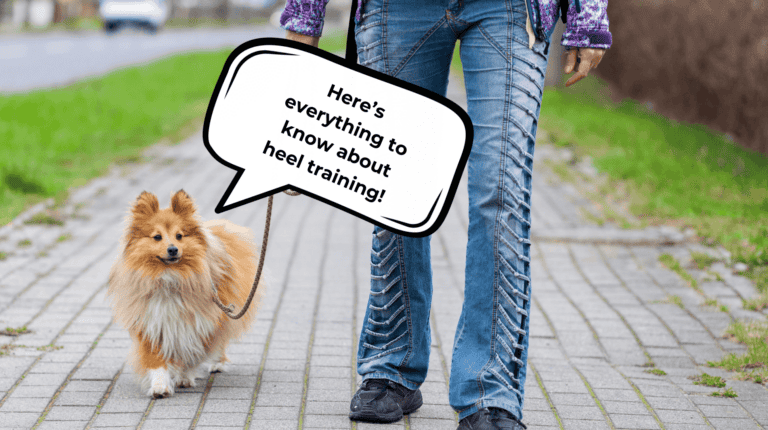
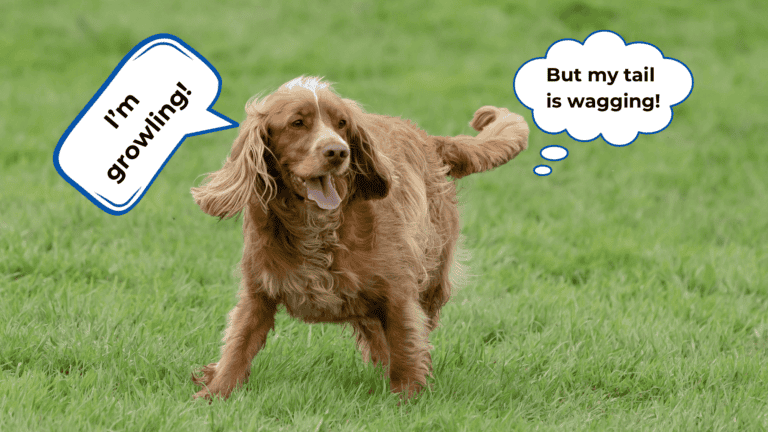
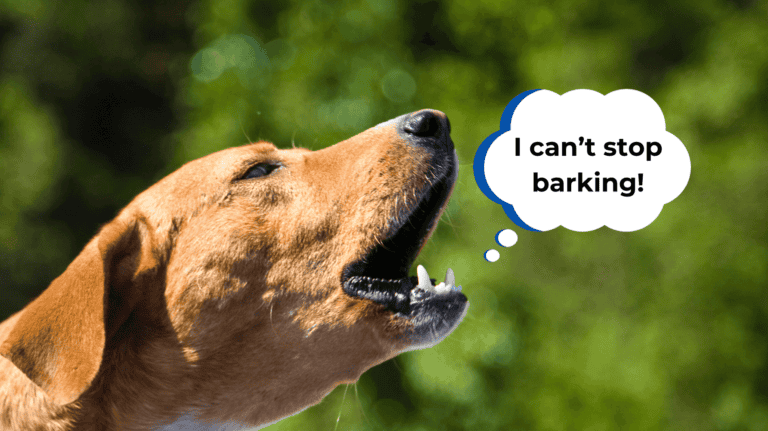

8 Responses
Hi
i have a female mixed Pitbull and bull terrier.
she is very calm and loving with family members.
she has serious bitten 3 people already. i have been urged to put her down.
i dont want to do this,
please help
Hi Yunus,
The most important thing to do when dealing with dogs who bite or are aggressive towards people is to understand why they are behaving this way. Once you do you can put measures into place to address their behaviour and start to calm things down. For example some dogs don’t like being approached by strangers and having their personal space invaded, it can leave them feeling vulnerable, so asking people not to approach your dog will help if this is a contributing factor.
My website TheOnlineDogTrainer.com shows you how to overcome this behaviour…maybe take a quick look…we currently have a FREE trial for 3 days…all the best Doggy Dan
How do I deal with a dog who is aggressive when disciplined?
Hi Rene,
Addressing unwanted behaviours in our dogs should always be done in a way that allows the dog to learn what behaviours are expected of them. The best approach when doing this is to be really clear and calm in your actions so as not to add stress or excitement to the situations. The information you give your dog may need to be different depending on the behaviour and situation they are in. For example verbally scolding or getting angry or upset with a dog for their behaviour can actually be really counterproductive and make their behaviour worse. They need to be able to understand exactly which behaviour they need reign in and if you are not clear in doing this or providing the right environment for learning then it can lead to confusion and frustration on their part. We take a lot of care in providing owners with the strategies and techniques to help overcome a vast range of unwanted behaviours, effectively and for the long-term. Maybe take a quick look at my website TheOnlineDogTrainer.com …its a $1USD trial for 3 days…all the best Doggy Dan
Hi Dan, I have a 4 yo Shorkie who is so protective of me that he will bite my husband if he comes near me. If I am not home, Bullet loves him and sits in his lap. He even does it often when I am home. He doesn’t want anyone else to come near me but he doesn’t bite them. Is there hope?
Hi Phyllis, yes there is hope and believe it or not I have worked with quite a few dogs who were protective of their owner. In most cases it all boils down to your dog believing that he is entitled to keep other rival males from approaching his female. Sounds a bit odd I know but in the minds of our dogs it’s perfectly sensible! If your husband approaches you make sure that he ignores your dog, especially avoiding eye contact. If your dog growls at your husband as he approaches then I would recommend placing your dog out of the room for a minute or two, and only allow him back in when he is silent for a few seconds first. This is all about showing him that you decide who gets to approach you and if he tries to intervene then he will lose you. There is no need to tell him off or get upset, just let your calm and consistent actions do the work for you. He will learn that if he wants to stay with you then he had better behave appropriately!
My website TheOnlineDogTrainer.com goes into this in a lot more detail if you were interested…maybe take a quick look…its a $1USD trial for 3 days…all the best Doggy Dan
Hi Dan
My daughter has two mixed lab dogs who are 3-4 years old.One is a really good dog and the other is very aggressive towards other dogs in the home including her sister.We have tried timeout putting her in a different room and nothing seems to help,she also growls sometimes at people who try to touch her,any suggestions?
Hi Susan, it’s really hard to provide a detailed solution to any behavioural issue in a short Blog post. The best long-term approach is to deal with the cause of the behaviour so that dogs no longer feel the need to exhibit those behaviours in the first place. My website TheOnlineDogTrainer.com shows you very clearly how to achieve this as we have a very detailed section on Aggression…maybe take a quick look…its a $1 trial for 3 days…all the best Doggy Dan